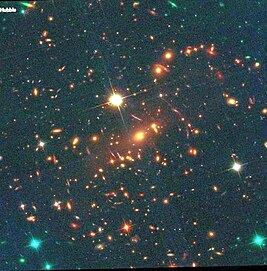Galaxy cluster in the constellation Volans
SMACS J0723.3–7327 , commonly referred to as SMACS 0723 , is a galaxy cluster about 4 billion light years from Earth,[ 2] constellation of Volans (RA/Dec = 110.8375, −73.4391667).[ 6] [ 7] [ 8] [ 9] Southern Hemisphere on Earth and often observed by the Hubble Space Telescope and other telescopes in search of the deep past.[ 2] first full-color image to be unveiled by the James Webb Space Telescope (JWST), imaged using NIRCam , with spectra included, showing objects lensed by the cluster with redshifts implying they are 13.1 billion years old.[ 10] Hubble Space Telescope (HST) as part of the Southern MAssive Cluster Survey (SMACS),[ 11] Planck [ 12] Chandra .[ 13]
In 2022, in the field gravitationally lensed by SMAC 0723, some of the then most ancient massive star clusters were discovered in a lensed galaxy called the "Sparkler Galaxy".[ 21]
References
^ a b c Coe, Dan; Salmon, Brett; Bradač, Maruša (October 2019). "RELICS: Reionization Lensing Cluster Survey" . Astrophysical Journal . 884 (1): 85. arXiv :1903.02002 Bibcode :2019ApJ...884...85C . doi :10.3847/1538-4357/ab412b S2CID 119041205 . ^ a b c Overbye, Dennis; Chang, Kenneth; Tankersley, Jim (11 July 2022). "Biden and NASA Share First Webb Space Telescope Image" . The New York Times . ISSN 0362-4331 . Retrieved 12 July 2022 . ^ "PSZ1 G284.97-23.69" . SIMBAD Centre de données astronomiques de Strasbourg . Retrieved 11 July 2022 .^ "PLCKESZ G284.99-23.70" . SIMBAD Centre de données astronomiques de Strasbourg . Retrieved 11 July 2022 .^ "SMACS J0723.3-7327" . NASA/IPAC Extragalactic Database.^ WRAL (10 July 2022). "SMACS J0723.3-7327" . WRAL.com . Retrieved 12 July 2022 . ^ "Astronomers eagerly await first images from the James Webb Space Telescope" . CBS News . Retrieved 12 July 2022 .^ "SRELICS" . irsa.ipac.caltech.edu . Retrieved 12 July 2022 .^ "RELICS: Reionization Lensing Cluster Survey" . archive.stsci.edu . Retrieved 12 July 2022 .^ "Webb's First Deep Field (NIRSpec MSA Emission Spectra)" . WebbTelescope.org . Retrieved 14 July 2022 .^ Repp, A.; Ebeling, H. (September 2018). "Science from a glimpse: Hubble SNAPshot observations of massive galaxy clusters" . Monthly Notices of the Royal Astronomical Society . 479 (1): 844– 864. arXiv :1706.01263 Bibcode :2018MNRAS.479..844R . doi :10.1093/mnras/sty1489 ^ "PSZ1 G284.97-23.69" . simbad.u-strasbg.fr . Retrieved 12 July 2022 .^ CXC-DS (2015). "Chandra Data Archive: Search Results" . Chandra X-ray Center/SAO . doi :10.25574/15296 . ^ Chow, Denise; Wu, Jiachuan (12 July 2022). "Photos: How pictures from the Webb telescope compare to Hubble's - NASA's $10 billion telescope peers deeper into space than ever, revealing previously undetectable details in the cosmos" . NBC News . Retrieved 16 July 2022 . ^ Garner, Rob (11 July 2022). "NASA's Webb Delivers Deepest Infrared Image of Universe Yet" . NASA Archived from the original on 12 July 2022. Retrieved 12 July 2022 . ^ Overbye, Dennis; Chang, Kenneth; Tankersley, Jim (11 July 2022). "Biden and NASA Share First Webb Space Telescope Image – From the White House on Monday, humanity got its first glimpse of what the observatory in space has been seeing: a cluster of early galaxies" . The New York Times Archived from the original on 12 July 2022. Retrieved 12 July 2022 . ^ Pacucci, Fabio (15 July 2022). "How Taking Pictures of 'Nothing' Changed Astronomy - Deep-field images of "empty" regions of the sky from Webb and other space telescopes are revealing more of the universe than we ever thought possible" . Scientific American . Retrieved 16 July 2022 . ^ Deliso, Meredith; Longo, Meredith; Rothenberg, Nicolas (14 July 2022). "Hubble vs. James Webb telescope images: See the difference" . ABC News . Retrieved 15 July 2022 . ^ Kooser, Amanda (13 July 2012). "Hubble and James Webb Space Telescope Images Compared: See the Difference - The James Webb Space Telescope builds on Hubble's legacy with stunning new views of the cosmos" . CNET . Retrieved 16 July 2022 . ^ Atkinson, Nancy (2 May 2022). "Now, We can Finally Compare Webb to Other Infrared Observatories" . Universe Today Archived from the original on 10 May 2022. Retrieved 12 May 2022 . ^ Robert Lea (29 September 2022). "James Webb Space Telescope spots 'Sparkler Galaxy' that could host universe's 1st stars" . SPACE.com.
External links


